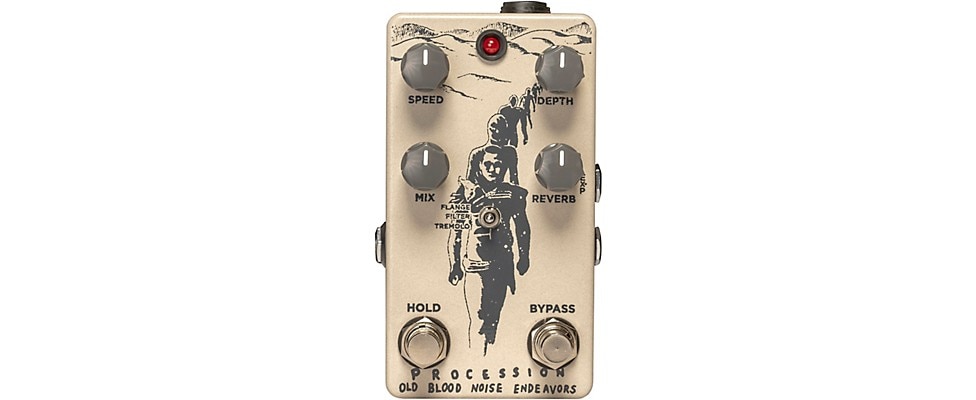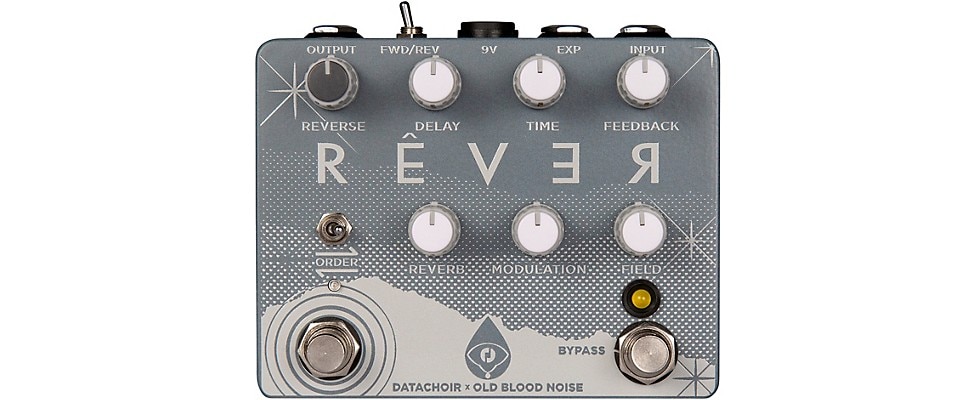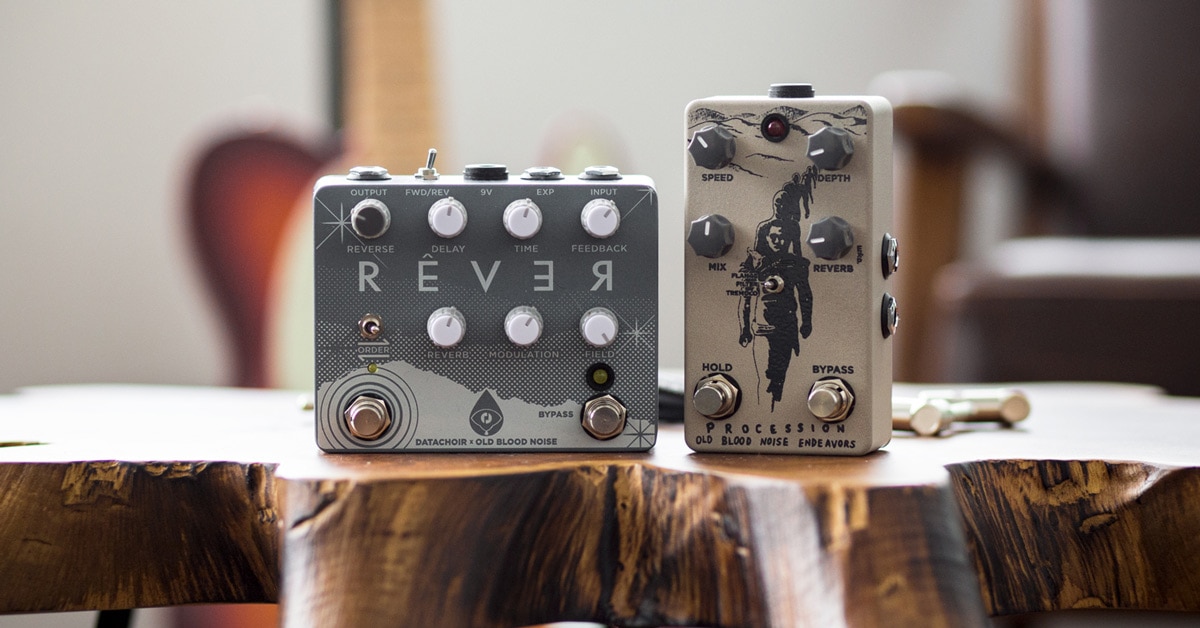Written by George Van Wagner, Musician's Friend Staff Writer
Old Blood Noise Endeavors, hereafter referred to as “OBNE,” has been rapidly building a reputation as a company that makes pedals that step beyond the sonic run-of-the-mill into a universe where time becomes liquid, and space warps into unfamiliar, but attractive configurations. I recently had a chance to spend some quality time with several of their pedals (you’ll find my reviews of the Black Fountain and Dark Star pedals elsewhere on this site), and would like to take this particular slot of space/time to talk a little about the Procession reverb pedal and OBNE’s latest, the Rever delay pedal.
Controlling the Procession
The terminology gets a little difficult here as the Procession is somewhat more than simply reverb and the Rever steps beyond a simple delay in some fairly profound ways. Let’s start with the Procession. OBNE refers to it as a “reverb with modulation” pedal. For a regular-size pedal package, there are a lot of controls here, and each one is useful. There are four knobs in all. The top two are used to control the Speed and Depth of modulation effect. A Mix knob takes you from 100% dry signal to 100% wet. The fourth knob, labeled Reverb, controls the length of decay, and, at full rotation, loops whatever is in the reverb at the time. This last function also works with the left of the two footswitches. This momentary Hold switch, depending on the setting of an internal switch, is assigned either to the reverb decay or to the modulation speed and, in effect, takes the selected function to its maximum position. The right-hand footswitch is a standard bypass switch. The three-position mini-toggle in the center of the pedal selects the modulation type—flanger, filter or tremolo. Finally, there’s an expression pedal input above the instrument input that works with any standard TRS expression pedal, like the Mission Engineering one I own.

Reverb: From Simple to Crazy
So what does the Procession sound like? The reverb is deep and dense, even on the lowest decay setting (Sample 1) and responds nicely to a range of dynamics. This is definitely a reverb that’s meant for creating large soundscapes. The modulation effects can go from barely there to fairly extreme via the depth control. Speed and depth are the only options available for the modulation section, but the controls have enough range to make that more than sufficient. If you should happen to want the rich reverb only, with no modulation, you can just select the Tremolo function and turn both depth and speed knobs to the zero position.
Things start to expand out with the use of the hold button and the expression pedal (Samples 2 and 3). When the hold function is active, dry signal still passes through the pedal, so, with the hold set in its reverb position, it’s easy to play a chord, freeze it with either the hold footswitch or expression pedal, then play over it. The held pads have a very appealing texture—almost an organ-like quality—and it can become a hypnotically engaging thing. The modulation knobs also continue to function on the held pad, so you can play with them to modify the frozen reverb loop, as I did in Sample 3.
Procession in Play
The Procession pedal offers some appealing options. The reverb is truly deep and evocative, and the ability to hold and freeze it on the fly opens up opportunities for creating haunting soundscapes, going way beyond a standard spring tank or other traditional reverb. It’s a great tool for loopers and the sonically adventurous musician. I can also see uses in the studio for processing sections of a mix. I had a lot of fun exploring what this one could do.
Reverse Time in its Tracks
Now we come to OBNE’s Rever pedal. Created in conjunction with the musical cooperative Datachoir, Rever uses a combination of delay, reverb modulation and reverse delay to create sounds that can go from subtle to over-the-top, haunting to just plain strange.
With a total of seven knobs, two mini-toggles, two footswitches and an expression pedal input, there’s a lot to wrap your mind around here, but after a little time spent twiddling with the controls, it’s mostly way easier than it looks at first glance. It helps if you read the manual first and take to heart the statement that Rever is really two separate processing blocks that share a box and a signal path. One block can reverse whatever you’re playing, either with the touch of a foot switch or with the expression pedal. The other feeds a modulated reverb into a delay.

Getting Underneath the Hood
The reverse delay block, which gives the pedal its name, gets the upper set of knobs. These are, from left to right, Reverse, which controls the blend of the delay and the normal signal, Delay, which controls the volume of the delay, Time, which sets the delay time from short doubles to a max of 400ms, and the Feed knob, which sets delay feedback from a single repeat to near-infinite. The momentary footswitch on the left side of the Rever works in conjunction with the Reverse knob, the mini toggle on the rear of the unit and the Order mini toggle switch on the face. This momentary switch toggles between forward and reverse, and the default (up) setting of this footswitch is set by the rear toggle. In simple terms, you can have things normally reversed, then turn them right way around with the footswitch, or vice versa, depending on your rear mini toggle setting.
The standard TRS expression pedal connection enables you to blend between the normal signal and the Reverse signal, essentially taking the place of the Reverse knob. I found this became my default setup with the Rever, enabling me to swell in and out of reverse sections, as well as getting a nicely controllable mid-position blend with the reverse delays becoming a subtle undertone.
The bottom set of knobs controls the modulated reverb/delay block. Reverb controls the reverb mix. Modulation governs the speed and depth of the modulation effect. The rightmost knob in this row, Field, controls the length/decay of the reverb.
Understanding Rever’s Signal Flow
The Rever’s two blocks are not in a fixed order. They can be swapped by the mini toggle switch directly above the leftmost footswitch. So, you can get reverse/forward delay into modulated reverb/delay or vice versa. This can make a huge difference in the end result (as you can hear in the solo sample). With the reverse block second, you get a choppier, more rhythmic sound. The modulated reverb block in the second position is a spacier, smoother tail.
Forwards and Back are Both Good
There’s a lot to play with here, and the Rever pedal has a lot of potential in many different signal chains. Unless your musical imagination runs far beyond the norm, this isn’t going to be an “always-on” pedal, but Rever’s unique controls and huge range of available textures can reward you with sounds and sonic twists that can be inspiring and will challenge you to rise to the occasion.
Pedal Stacking Synergy — Combining Rever and Procession
The most fun was stacking these two pedals together and just creating some little soundscapes on the fly. An afternoon messing with my DAW and just these two pedals fired up my musical imagination in a number of unexpected ways. They made me play fewer notes because the decay and warpage of the sound was so fascinating to listen to. Together, these pedals are a certified blast. Returning them after the review will cause a brief period of mourning until I can manage to score a couple that I can keep.
Audio Demos
Notes on the recordings: As usual, no additional effects were used in capturing these samples. Signal chain was a Strat loaded with noiseless pickups into the pedals, which were powered by a Voodoo Lab Pedal Power 2 Plus, into a Fuchs ODS, Two Notes Audio Engineering Captor 8 and Two Notes Audio Engineering C.A.B-M IR loader directly to the input of a Focusrite Saffire audio interface and recorded in Logic Pro X.







































































































































